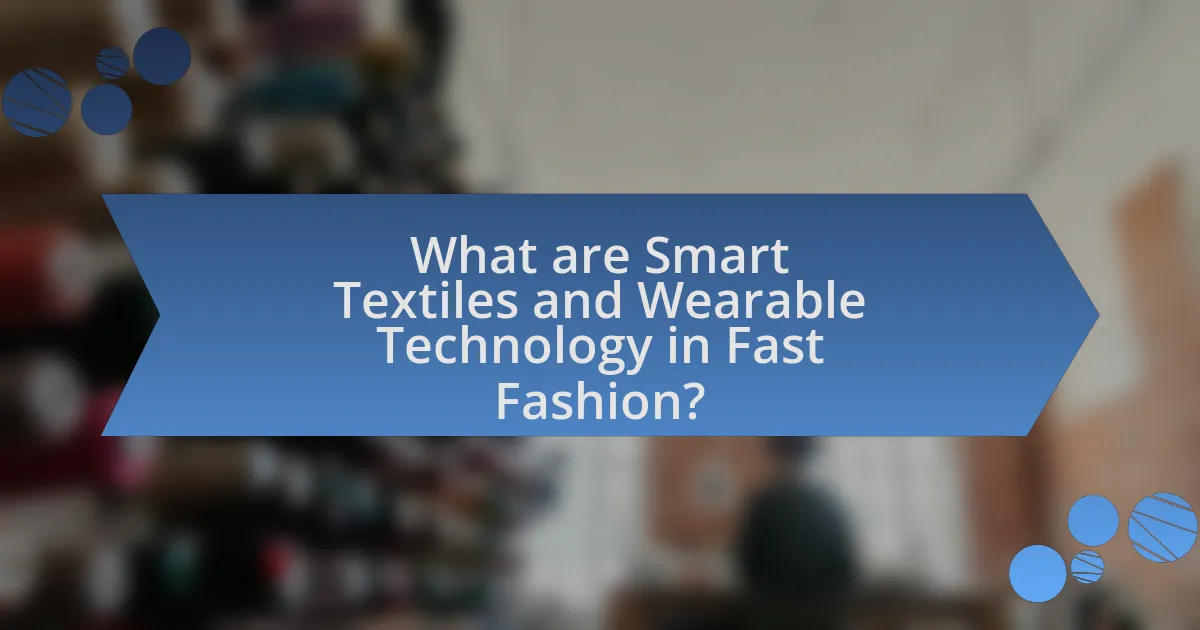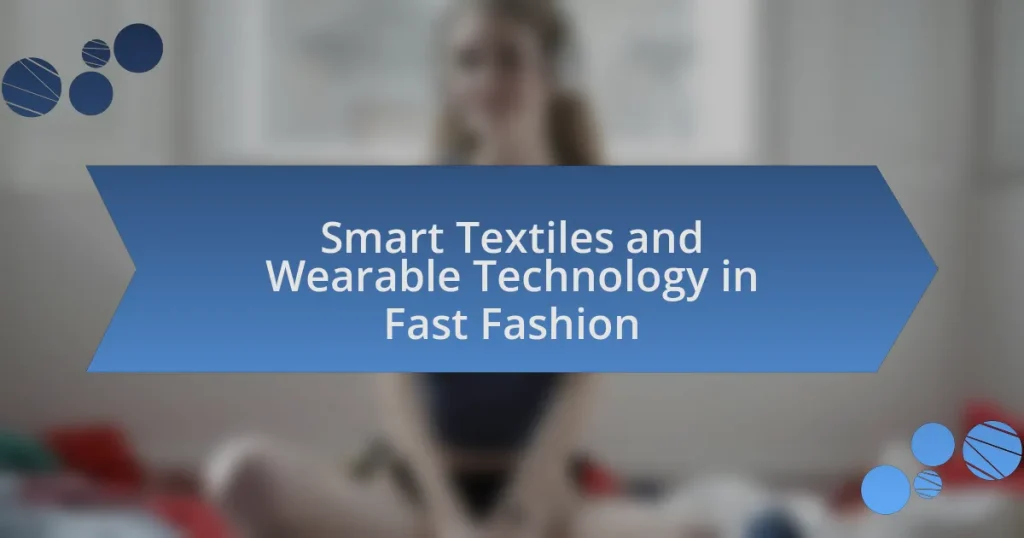Smart textiles and wearable technology represent a significant innovation in the fast fashion industry, merging aesthetics with functionality. These advanced fabrics are embedded with sensors and conductive materials, enabling real-time health monitoring, temperature regulation, and moisture management. The article explores how these technologies enhance user experience, the materials used in their production, and the driving trends behind their adoption in fast fashion. It also addresses the challenges faced, including sustainability concerns and technological limitations, while highlighting future trends and best practices for brands aiming to integrate these innovations effectively.

What are Smart Textiles and Wearable Technology in Fast Fashion?
Smart textiles are fabrics embedded with technology that enables them to interact with the environment or the wearer, while wearable technology refers to electronic devices worn on the body that can monitor health, fitness, or provide connectivity. In fast fashion, these innovations allow for rapid production of clothing that not only meets aesthetic demands but also incorporates functionalities such as temperature regulation, moisture management, and health tracking. For instance, a study by the Fashion Institute of Technology highlights that smart textiles can enhance user experience by providing real-time data on body temperature and activity levels, thereby merging fashion with functionality.
How do Smart Textiles integrate with Wearable Technology?
Smart textiles integrate with wearable technology by embedding sensors and conductive materials into fabrics, enabling real-time data collection and interaction with electronic devices. This integration allows garments to monitor physiological parameters such as heart rate, temperature, and movement, enhancing user experience and functionality. For instance, a study published in the journal “Advanced Functional Materials” demonstrates how smart textiles can transmit data wirelessly to smartphones, facilitating health monitoring and fitness tracking. This synergy between smart textiles and wearable technology not only promotes innovation in fashion but also supports the growing demand for health-conscious and performance-enhancing apparel.
What materials are used in Smart Textiles?
Smart textiles are primarily made from conductive fibers, polymers, and smart materials such as shape memory alloys and piezoelectric materials. Conductive fibers, often made from metals like silver or copper, enable the transmission of electrical signals. Polymers, including elastomers and thermoplastics, provide flexibility and durability while integrating sensors and actuators. Smart materials, like shape memory alloys, can change their properties in response to environmental stimuli, enhancing functionality. These materials are essential for applications in health monitoring, temperature regulation, and interactive clothing, demonstrating their versatility and importance in the field of wearable technology.
How do these materials enhance functionality in fashion?
Smart textiles and wearable technology enhance functionality in fashion by integrating advanced features such as moisture-wicking, temperature regulation, and health monitoring. These materials utilize embedded sensors and conductive fibers to respond to environmental changes, improving comfort and performance. For instance, fabrics that regulate temperature can adapt to body heat, providing a more comfortable wearing experience in varying climates. Additionally, health-monitoring textiles can track biometric data, offering users real-time insights into their physical condition, which is particularly beneficial for athletes and health-conscious individuals. This integration of technology into textiles not only elevates the user experience but also aligns with the growing demand for multifunctional apparel in the fast fashion industry.
Why is Fast Fashion adopting Smart Textiles and Wearable Technology?
Fast fashion is adopting smart textiles and wearable technology to enhance consumer engagement and streamline production processes. By integrating these technologies, brands can offer innovative features such as real-time data collection on user preferences and body metrics, which allows for personalized shopping experiences. Additionally, smart textiles can improve garment functionality, such as moisture-wicking or temperature regulation, appealing to health-conscious consumers. The global smart textiles market is projected to reach $5.3 billion by 2024, indicating a significant trend towards innovation in the fashion industry. This adoption not only meets consumer demand for advanced features but also helps brands differentiate themselves in a competitive market.
What trends are driving the integration of technology in fashion?
The integration of technology in fashion is primarily driven by trends such as sustainability, personalization, and enhanced consumer experience. Sustainability is increasingly important, with brands adopting smart textiles that reduce waste and energy consumption; for instance, companies like Adidas are using recycled ocean plastic in their products. Personalization is facilitated by data analytics and AI, allowing brands to tailor offerings to individual consumer preferences, as seen with platforms like Stitch Fix. Enhanced consumer experience is achieved through wearable technology, such as fitness trackers and smart clothing, which provide real-time data and connectivity, exemplified by brands like Under Armour incorporating sensors into their apparel. These trends collectively reflect a shift towards a more innovative, responsive, and responsible fashion industry.
How does consumer demand influence this adoption?
Consumer demand significantly influences the adoption of smart textiles and wearable technology in fast fashion by driving innovation and shaping product offerings. As consumers increasingly seek functionality, sustainability, and personalization in their clothing, brands respond by integrating advanced materials and technologies that meet these preferences. For instance, a report by McKinsey & Company highlights that 66% of consumers are willing to pay more for sustainable brands, prompting fast fashion companies to adopt smart textiles that enhance sustainability and performance. This alignment between consumer expectations and product development accelerates the integration of wearable technology into mainstream fashion, ultimately shaping market trends and driving competitive advantage.
What challenges do Smart Textiles and Wearable Technology face in Fast Fashion?
Smart textiles and wearable technology face significant challenges in fast fashion, primarily due to rapid production cycles and consumer demand for low-cost items. The integration of advanced materials and technology into clothing often results in higher production costs, which conflicts with the fast fashion model that prioritizes affordability and quick turnover. Additionally, the durability and maintenance of smart textiles can be problematic, as consumers may not be willing to invest in garments that require special care or have a limited lifespan. Furthermore, the environmental impact of producing electronic components within textiles poses sustainability issues, as fast fashion is already criticized for its ecological footprint. These challenges highlight the difficulty of aligning innovative textile technologies with the fast-paced, cost-sensitive nature of the fast fashion industry.
What are the technological limitations currently encountered?
The technological limitations currently encountered in smart textiles and wearable technology in fast fashion include issues related to durability, power supply, and data integration. Durability is a significant concern, as many smart textiles are not able to withstand the wear and tear associated with regular use, leading to a shorter lifespan of the products. Power supply limitations arise from the need for lightweight and flexible energy sources, which are often not sufficiently developed to support continuous operation of embedded technologies. Additionally, data integration poses challenges, as the seamless collection and analysis of data from wearable devices can be hindered by compatibility issues with existing systems and the need for advanced algorithms to process the information effectively. These limitations hinder the widespread adoption and functionality of smart textiles in the fast fashion industry.
How do sustainability concerns impact the development of these technologies?
Sustainability concerns significantly influence the development of smart textiles and wearable technology in fast fashion by driving innovation towards eco-friendly materials and production processes. As consumers increasingly demand sustainable products, manufacturers are compelled to adopt practices that minimize environmental impact, such as using biodegradable fabrics and reducing waste through efficient design. For instance, a report by McKinsey & Company highlights that 67% of consumers consider sustainability when making fashion purchases, prompting brands to integrate sustainable technologies into their offerings. This shift not only addresses consumer preferences but also aligns with regulatory pressures aimed at reducing the fashion industry’s carbon footprint, thereby accelerating the adoption of sustainable practices in the development of these technologies.
How do Smart Textiles and Wearable Technology enhance user experience?
Smart textiles and wearable technology enhance user experience by providing personalized, real-time feedback and functionality that adapts to individual needs. These innovations allow users to monitor health metrics, such as heart rate and temperature, directly through their clothing, which promotes a more engaged and informed lifestyle. For instance, a study published in the journal “Sensors” highlights that wearable devices can improve user motivation and adherence to fitness goals by delivering immediate data and insights. Additionally, smart textiles can adjust to environmental conditions, such as temperature regulation, enhancing comfort and usability in various settings. This integration of technology into everyday wear not only increases convenience but also fosters a deeper connection between users and their clothing, ultimately transforming the way individuals interact with fashion.
What functionalities do these technologies provide to consumers?
Smart textiles and wearable technology in fast fashion provide functionalities such as real-time health monitoring, enhanced comfort through adaptive materials, and personalized fashion experiences. These technologies enable consumers to track vital signs like heart rate and body temperature, which can lead to improved health management. Additionally, smart textiles can adjust to environmental conditions, offering better temperature regulation and moisture control. Furthermore, wearable technology allows for customization of clothing styles and features, enhancing user engagement and satisfaction. For instance, a study by the Massachusetts Institute of Technology highlighted that smart fabrics can change color or pattern based on user preferences, showcasing the innovative capabilities of these technologies in the fashion industry.
How do they improve comfort and performance in clothing?
Smart textiles and wearable technology improve comfort and performance in clothing by integrating advanced materials and sensors that adapt to the wearer’s needs. These textiles can regulate temperature, wick moisture, and provide support through features like stretchability and breathability. For instance, phase change materials (PCMs) can absorb, store, and release heat, maintaining a comfortable body temperature during various activities. Additionally, moisture-wicking fabrics draw sweat away from the skin, enhancing comfort during physical exertion. Research indicates that garments incorporating these technologies can lead to improved athletic performance by reducing fatigue and increasing endurance, as evidenced by studies showing enhanced thermal regulation and moisture management in activewear.
What are the future trends for Smart Textiles and Wearable Technology in Fast Fashion?
Future trends for smart textiles and wearable technology in fast fashion include increased integration of sustainability, enhanced functionality, and personalization. The demand for eco-friendly materials is driving brands to develop textiles that are not only smart but also biodegradable or recyclable. Additionally, advancements in sensor technology are enabling garments to monitor health metrics, providing consumers with real-time data on their well-being. Personalization through data analytics allows for tailored fashion experiences, where consumers can receive recommendations based on their preferences and behaviors. These trends are supported by market research indicating that the global smart textiles market is projected to reach $5.3 billion by 2024, reflecting a growing consumer interest in innovative and functional fashion solutions.
How is innovation shaping the future of fashion technology?
Innovation is shaping the future of fashion technology by integrating smart textiles and wearable technology, which enhance functionality and user experience. For instance, advancements in materials science have led to the development of fabrics that can monitor health metrics, such as heart rate and temperature, providing real-time data to users. Companies like Nike and Under Armour have already implemented moisture-wicking and temperature-regulating fabrics in their athletic wear, demonstrating the practical application of these innovations. Furthermore, the rise of augmented reality (AR) in fashion allows consumers to virtually try on clothing, significantly improving the shopping experience and reducing return rates. According to a report by McKinsey & Company, the global market for smart textiles is projected to reach $5 billion by 2024, underscoring the significant impact of innovation on the fashion industry.
What role will data analytics play in the evolution of these technologies?
Data analytics will play a crucial role in the evolution of smart textiles and wearable technology in fast fashion by enabling real-time insights into consumer behavior and preferences. This capability allows brands to tailor their products more effectively, optimizing design and production processes based on data-driven decisions. For instance, analytics can track trends in fabric performance and user engagement, leading to innovations that enhance functionality and comfort. Furthermore, a report by McKinsey & Company highlights that data analytics can reduce lead times and improve inventory management, which is essential for the fast-paced nature of the fashion industry. This integration of data analytics will ultimately drive efficiency and responsiveness in the development of smart textiles and wearable technology.
What best practices should brands follow when implementing Smart Textiles and Wearable Technology?
Brands should prioritize user-centered design when implementing Smart Textiles and Wearable Technology. This involves understanding the needs and preferences of the target audience to create products that enhance user experience and functionality. Additionally, brands should ensure robust data security and privacy measures, as wearables often collect sensitive personal information. Compliance with industry standards and regulations, such as GDPR for data protection, is essential to build consumer trust.
Furthermore, brands should invest in high-quality materials and technology to ensure durability and performance, as evidenced by the increasing consumer demand for sustainable and long-lasting products. Collaborating with technology partners can also enhance innovation and integration capabilities, allowing for more advanced features and functionalities. Lastly, conducting thorough testing and gathering user feedback during the development phase can lead to improved product iterations and market success.
How can brands ensure sustainability in their technology integration?
Brands can ensure sustainability in their technology integration by adopting eco-friendly materials and energy-efficient processes. For instance, utilizing organic or recycled fibers in smart textiles reduces environmental impact, while implementing energy-efficient manufacturing technologies minimizes carbon emissions. Research indicates that the fashion industry can reduce its carbon footprint by up to 30% through sustainable practices, as highlighted in the “Fashion on Climate” report by McKinsey & Company. Additionally, brands can invest in lifecycle assessments to evaluate the environmental impact of their products from production to disposal, ensuring that sustainability is prioritized throughout the entire supply chain.
What strategies can enhance consumer engagement with these technologies?
To enhance consumer engagement with smart textiles and wearable technology in fast fashion, brands should implement interactive experiences that allow consumers to personalize their products. Personalization increases emotional connection and satisfaction, leading to higher engagement levels. For instance, brands like Nike have successfully utilized customization platforms, enabling consumers to design their own shoes, which has resulted in increased sales and customer loyalty. Additionally, integrating social media sharing features can amplify consumer interaction, as seen with platforms like Instagram, where users showcase their unique styles, further promoting brand visibility and engagement.















